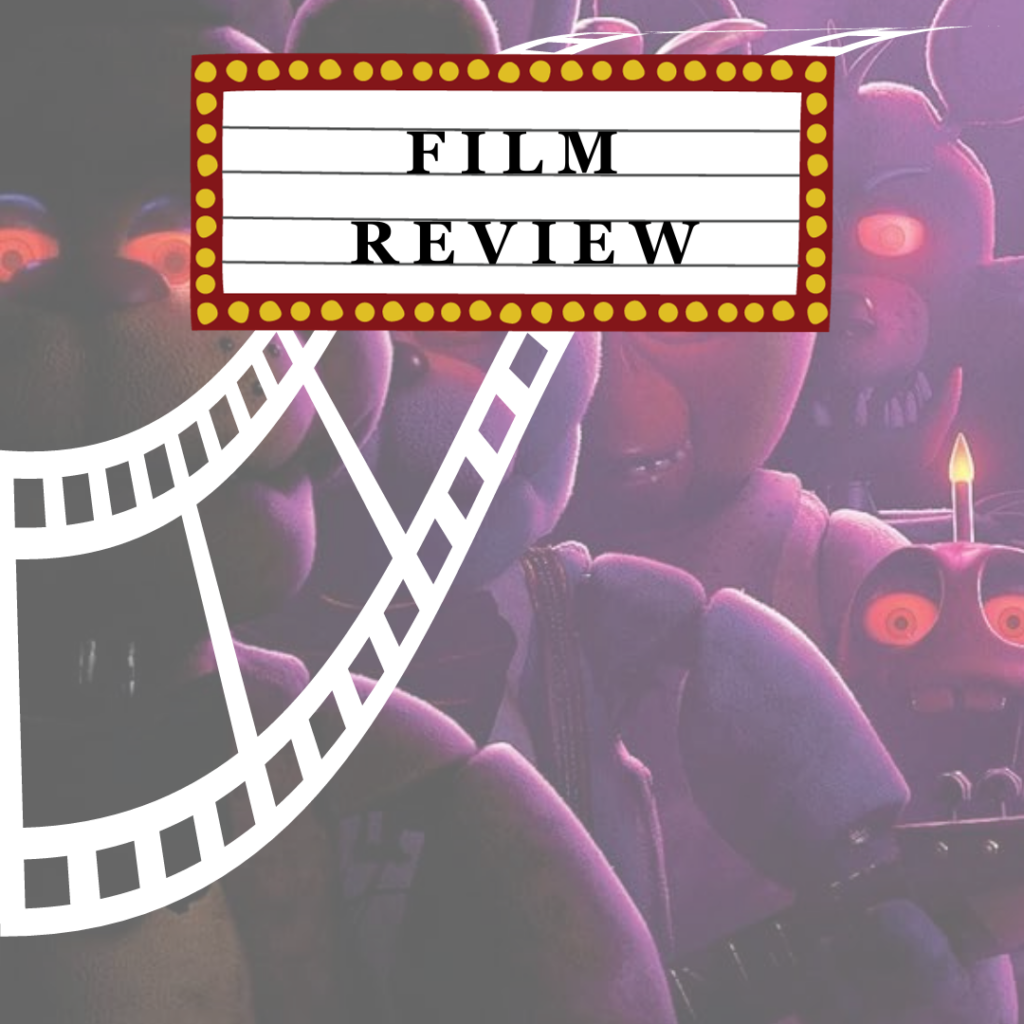
(Photo Manipulation by Ari Segal)
Rumors of a “Five Nights at Freddy’s” (FNAF) film have circulated since 2015. Eight years, nine games and two book series later, the first trailer for the film was released in May. As a retired FNAF historian, I was surprised and delighted, along with many other fans. The film premiered in theaters on Oct. 27, one day after its release on Peacock.
“Five Nights at Freddy’s,” directed by Emma Tammi, follows Mike Schmidt (Josh Hutcherson), a man who takes a night guard job at the out-of-business Freddy Fazbear’s Pizza in order to keep custody of his younger sister, Abby Schmidt (Piper Rubio).
The true stars of this film are the animatronics, created using practical effects, without computer-generated images. The Freddy Fazbear, Bonnie, Chica and Foxy seen on screen are tangible, real-world props. The importance of this choice cannot be understated. Seeing the way animatronics take up physical space and interact with the world around them not only invokes awe, but terror.
Viewers see how the animatronics tower over the human protagonist Mike and how their bulbous bodies navigate space with thundering footsteps. The texture, the fuzziness of their fur, the mildewy and dirty spots from years of age are rendered in great detail. The animatronics feel real, and that gives them a bone-chilling, imposing presence.
Though the designs of the animatronics are accurate to the first FNAF game, the film does not directly adapt any single game or book in the franchise, instead drawing from all corners of the canon. While Mike and the animatronics are from “Five Nights at Freddy’s,” characters from “Five Nights At Freddy’s: Help Wanted,” “Five Nights at Freddy’s 2” and “Five Nights at Freddy’s: Sister Location” appeared as well. Major plot elements in the film, such as the five missing children and the possessed animatronics, are staples of the franchise that have existed since the first game.
A film adaptation of the FNAF games has always posed an issue, as the gameplay consists of the player character checking cameras, flashing lights and sometimes closing doors, all from a stationary point of view. Players are not given access to the interior lives of the protagonists, who are purely conduits for gameplay.
This film is allegedly attempting to adapt the FNAF games, yet Mike does not perform any security duties, and the animatronics never seriously threaten his life. A carbon copy of gameplay is not necessary for an adaptation— in fact, that would have been boring to watch — but by failing to include staples of gameplay, the film loses the essence of FNAF.
However, the film made a wise decision to flesh out Mike’s world, introducing family members and a new backstory: Main antagonist William Afton (Matthew Lillard) abducted Mike’s brother as a child. This traumatic incident in Mike’s past gives him a reason to get invested in the Freddy Fazbear Pizza missing children’s incident from the ’80s.
Other new elements, however, were integrated clumsily — namely, the custody battle subplot. The serious legal issue sticks out like a sore thumb among the slasher gore and ghost robot antics. Mike’s Aunt Jane (Mary Stuart Masterson) is a walking plot device, a truly goofy villain who does nothing but send her goons to stir up trouble and get killed. This subplot subsumes the early part of the film, turning the opening into a boring slog until the animatronics appear.
Two other key elements of FNAF gameplay, the dark hallways and electricity management, are completely absent. In the games, the hallways are either unable to be obstructed, as seen in the second and the third FNAF game, or can only be obstructed at the expense of power, as seen in the first. This creates the central tension of FNAF gameplay, a push and pull between the player’s fear of the dark hallways and the animatronics that lurk in them and the player’s need to preserve power.
This tension is completely absent from the film. Mike’s office has a normal door with a handle that can be closed without consequence. Though the electricity in the Freddy Fazbear Pizza is buggy, power conservation is never a concern. The security cameras are present as set dressing — Mike never uses them to monitor the animatronics.
This is why, despite the fact that the animatronics look great, they are not utilized to full effect in the film. The animatronics are not allowed to threaten Mike’s life seriously and are further stripped of their capacity to be scary by acting as intelligent, sentient creatures.
In the games, the animatronics are enigmatic. They are vengeful spirits, unable to be understood. The machines want to kill the player character, the player doesn’t know why and is unable to stop them — that is scary.
However, the animatronics in the film are perfectly capable of reasoning. At the one hour mark, the protagonists are building pillow forts with them — not an exaggeration, by the way — and Mike is verbally communicating with their ghosts in his dreams. The film’s animatronics are expressive, emotive and extremely human-like, a far cry from the hulking, blank-faced killing machines of the games. By humanizing and cutesifying the animatronics, the film strips them of their potential to induce fear.
I was left wondering: Why did this film even bother being an adaptation? Though the film features characters and settings from the games, it felt like the screenwriters were just playing with action figures and writing bad fan fiction. The film wants to be deeply entrenched in FNAF lore, yet it fails to capitalize on what made the games scary in the first place.
The final product is a garbled amalgamation of lore, amusing ’80s aesthetics and references for the fans. Unfortunately, a MatPat cameo does not distract from two hours of messy storytelling. The film is not quite scary, not quite funny and absolutely uninteresting, leaving a final product that confuses newcomers, leaves fans strung out and ultimately pleases no one.
Alexandra Kauffman (26C) is an English & Creative Writing major from Phoenix, Arizona. At the Wheel, she is an Emory Life section editor and Arts & Entertainment campus desk. Outside of the wheel, she is a member of Alloy Literary Magazine. She is also a science fiction enthusiast and enjoyer of the bizarre.







